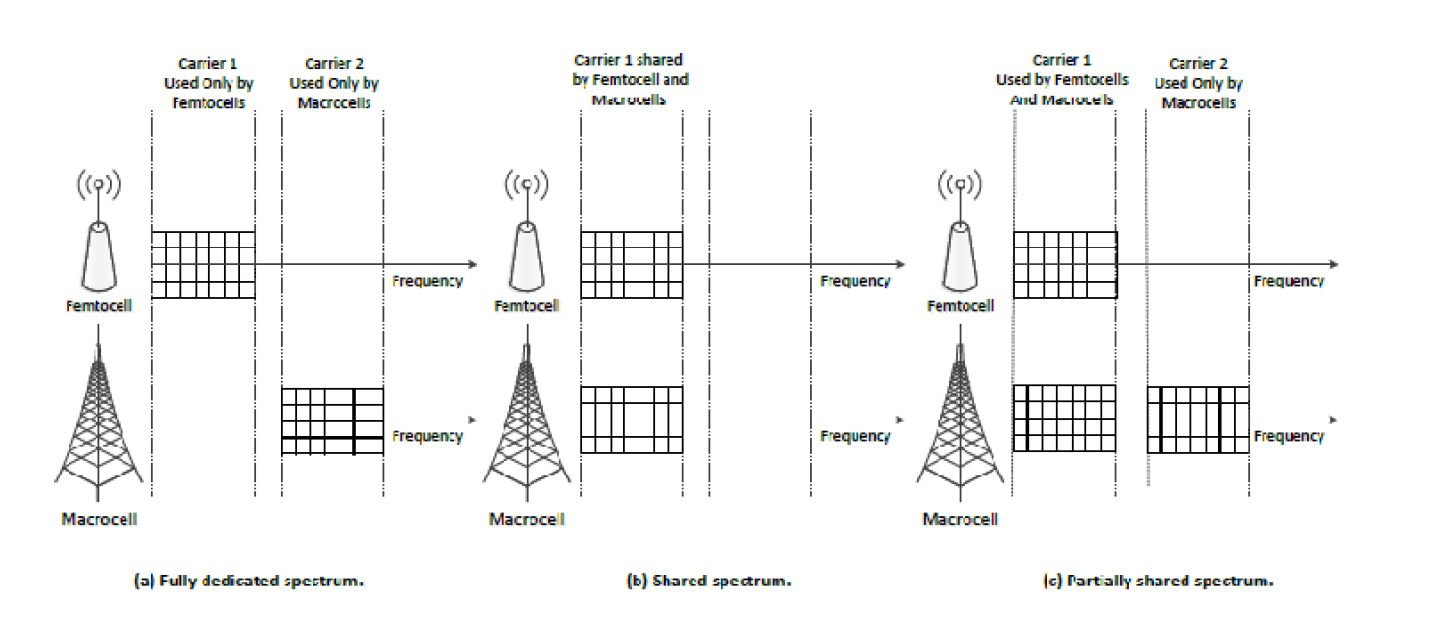Interference mitigation in heterogeneous networks
Published:
This post covers Mobile and Wireless Networks by Khaldoun Al Agh, Guy Pujolle, and Tara Ali-Yahiya.
Basic Ideas
Interference mitigation - Fundamental System Design
- A HetNet consists of a classical macrocell layout with low power nodes placed throughout their coverage zones. Consequently, a HetNet has completely different interference characteristics compared to homogeneous deployment and attention must be paid to these differences when planning frequency reuse.
- We are interested in the interference generated in two-tier systems, and more especially macrocell/femtocell and macrocell/picocell systems.
- The interference in two-tier networks is generally of two types:
- co-tier interference, which occurs between cells belonging to the same tier, for example between two neighboring femtocells or macrocells;
- cross-tier interference, which occurs between cells belonging to different tiers, such as femtocell and macrocell or vice-versa.
Interference mitigation in the context of two-tier macro femtocells
Generally, the impact of interference between different tiers, in our case macrofemtocells, depends on the techniques used for spectrum assignment and/or the access method used by the network.
Interference in cross-tier heterogeneous networks can be mitigated via appropriate frequency reuse schemes, especially when the operator exploits several licensed bands.
Several options can be considered for frequency allocation:
\1) Fully dedicated band: each tier of the overlaid network is assigned a different frequency band; consequently the cross-tier interference is totally avoided.
This approach shows low network spectral efficiency because each tier can only access a subset of the frequency resources.
If we consider the case of LTE, which is based on OFDMA technology, the terminology “orthogonal allocation” is usually used and the available subchannels are divided into two subsets, one used only by the macrocell tier, the other allocated to the femtocell tier.
\2) Shared spectrum band (universal reuse scheme): both tiers share the same frequency band leading to use of total frequency band.
Despite this positive aspect (in terms of spectral efficiency), this method produces severe interference that would degrade overall network performance and has to be handled.
In LTE OFDMA systems, this allocation is referred to as “co-channel” assignment.
\3) Partially shared band: is an intermediate solution which provides a tradeoff between spectral efficiency and cross-tier interference by combining the fully dedicated and shared spectrum approaches.
In this assignment scheme, macrocell users can access the whole frequency spectrum, while femtocells operate in a subset of it.
If some MUEs experience high interference in the shared spectrum due to their vicinity of the coverage of the other tiers, the are moved to the dedicated band in below figure. This approach is referred to as “hybrid assignment” in the LTE system.

Interference mitigation in the context of two-tier macro picocells
- The interference mitigation problem generated in a scenario where the macro and picocells coexist is different from the one presented in the macro and femtocell context.
- This is mainly due to the open access nature of picocells’ deployment as they are managed for the network operator.
- Unlike the closed access mode femtocells, picocells can always handle macrocell users. Hence, the mobile terminals are always associated with a cell offering a higher quality of Reverse Reservation Protocol (RSRP).
- Nevertheless, the user association with the highest RSRP might not always be desirable due to:
- – load-balancing: as the range of picocell areas is much smaller than the macrocells as well as the mobility behavior of most cell phone users, the number of mobile terminals served by the PBSs is much smaller than the number of MBS users.
- Consequently, the amount of traffic in the picocell may change very dynamically, leading to unbalanced load among different tiers;
- – mobility consideration: as in any other open-access small cell, cell phone users served by the picocell experience interference from either macrocells and/or neighboring picocells.
- The mobility behavior causes the mobile user rapidly to change their served cell, or the undesired strength signal is detected where the Radio Link Failure (RLF) procedure is declared and the mobile user desires to reinitiate to the strongest RSRP.
- Consequently, the number of handover procedures is expected to increase compared to that for homogenous networks.